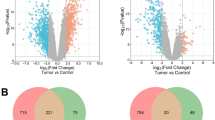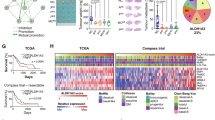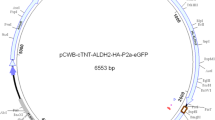Abstract
Aim:
To construct an eukaryotic expression vector containing the aldehyde dehydrogenase-2 (ALDH2) gene, and determine whether transfection with the ALDH2 gene can provide protection against hydrogen peroxide-induced oxidative damage, as well as attenuate apoptosis or cell death in human peripheral blood mononuclear cells (PBMCs).
Methods:
The ALDH2 gene was cloned from human hepatocytes by RT-PCR. The eukaryotic expression vector containing the gene was constructed and then transfected into PBMCs via liposomes. RT-PCR, indirect immunofluorescence assay, and Western blot were used to evaluate the expression of the transgene in target cells. MTT assay and flow cytometry were used to detect the effects of ALDH2 on PBMCs damaged by hydrogen peroxide (H2O2). The level of intracellular reactive oxygen species (ROS) was determined by fluorescence spectrophotometry.
Results:
The eukaryotic expression vector pcDNA3.1/myc-His-ALDH2 was successfully constructed and transfected into PBMCs. RT-PCR results showed higher mRNA expression of ALDH2 in the gene-transfected group than in the two control groups (empty vector-transfected group and negative control). Indirect immunofluorescence assay and Western blot indicated distinct higher protein expression of ALDH2 in the gene-transfected group. The cell survival rate against H2O2-induced oxidative damage was higher in the ALDH2 gene-transfected group. Moreover, apoptosis rates in gene-transfected PBMCs incubated with 50 and 75 μmol/L H2O2 decreased by 7% and 6%, respectively. The generation of intracellular ROS was also markedly downregulated.
Conclusion:
ALDH2 gene transfection can protect PBMCs against H2O2-induced damage and attenuate apoptosis, accompanied with a downregulation of intracellular ROS. ALDH2 functions as a protector against oxidative stress.
Similar content being viewed by others
Log in or create a free account to read this content
Gain free access to this article, as well as selected content from this journal and more on nature.com
or
References
Komori T, Sugiyama H, Ogawa H, Oka Y, Miyake S, Soma T, et al. Treatment of a patient in a relapse after bone marrow transplantation for acute lymphoblastic leukemia with the systemic administration of allogeneic lymphokine-activated killer cells and recombinant interleukin-2. Eur J Haematol 1989; 43: 184–5.
Tricarico M, Rinaldi M, Bonmassar E, Fuggetta MP, Barrera G, Fazio VM . Effect of 4-hydroxynonenal, a product of lipid peroxidation, on natural cell mediated cytotoxicity. Anticancer Res 1999; 19: 5149–54.
Schmielau J, Finn O J . Activated granulocytes and granulocyte-derived hydrogen peroxide are the underlying mechanism of suppression of T-cell function in advanced cancer patients. Cancer Res 2001; 61: 4756–60.
Mellqvist UH, Hansson M, Brune M, Dahlgren C, Hermodsson S, Hellstrand K . Natural killer cell dysfunction and apoptosis induced by chronic myelogenous leukemia cells: role of reactive oxygen species and regulation by histamine. Blood 2000; 96: 1961–8.
Tseng YM, Chen SY, Chen CH, Jin YR, Tsai SM, Chen IJ, et al. Effects of alcohol-induced human peripheral blood mononuclear cell (PBMC) pretreated whey protein concentrate (WPC) on oxidative damage. J Agric Food Chem 2008; 56: 8141–7.
Kaysen GA, Eiserich JP . The role of oxidative stress-altered lipoprotein structure and function and microinflammation on cardiovascular risk in patients with minor renal dysfunction. J Am Soc Nephrol 2004; 15: 538–48.
Kraśniak A, Drozdz M, Pasowicz M, Chmiel G, Kowalczyk-Michałek M, Szumilak D, et al. Influence of microinflammation and oxidative stress on atherosclerosis progression and calcifications in cardiovascular system of hemodialyzed patients during two years follow-up. Przegl Lek 2007; 64: 140–7.
Mena S, Ortega A, Estrela JM . Oxidative stress in environmental-induced carcinogenesis. Mutat Res 2009; 674: 36–44.
Uttara B, Singh AV, Zamboni P, Mahajan RT . Oxidative stress and neurodegenerative diseases: a review of upstream and downstream antioxidant therapeutic options. Curr Neuropharmacol 2009; 7: 65–74.
Mizutani H, Tada-Oikawa S, Hiraku Y, Kojima M, Kawanishi S . Mechanism of apoptosis induced by doxorubicin through the generation of hydrogen peroxide. Life Sci 2005; 76: 1439–53.
Rosato RR, Almenara JA, Maggio SC, Coe S, Atadja P, Dent P, et al. Role of histone deacetylase inhibitor-induced reactive oxygen species and DNA damage in LAQ-824/fludarabine antileukemic interactions. Mol Cancer Ther 2008; 7: 3285–97.
Fang J, Nakamura H, Iyer AK . Tumor-targeted induction of oxystress for cancer therapy. J Drug Target 2007;15: 475–86.
Li SY, Mark G, Jinhong D . Overexpression of aldehyde dehydrogenase-2 transgene prevents acetaldehyde induced cell injury in human umbilical vein endothelial cells. J Biol Chem 2004; 279: 11244–52.
Xu D, Guthrie JR, Mabry S, Sack TM, Truog WE . Mitochondrial aldehyde dehydrogenase attenuates hyperoxia-induced cell death through activation of ERK/MAPK and PI3K-Akt pathways in lung epithelial cells. Am J Physiol Lung Cell Mol Physiol 2006; 291: L966–75.
Ohta S, Ohsawa I . Links dysfunction of mitochondria and oxidative stress in the pathogenesis of Alzheimer's disease: on defects in the cytochrome c oxidase complex and aldehyde detoxification. J Alzheimers Dis 2006; 9: 155–66.
Li DB, Wang JS, Fang Q, Sun HY, Xu W, Li WD . Protective effect of O6-methylguanine-DNA-methyltransferase on mammalian cells. Chin Med J 2007; 120: 714–7.
Wang JS, Fang Q, Sun DJ, Chen J, Zhou XL, Lin GW, et al. Genetic modification of hematopoietic progenitor cells for combined resistance to 4-hydroperoxycyclophosphamide, vincristine, and daunorubicin. Acta Pharmacol Sin 2001; 22: 949–55.
Wu WJ, Pruett SB . Suppression of splenic natural killer cell activity in a mouse model for binge drinking. II. Role of the neuroendocrine system. J Pharmacol Exp Ther 1996; 278: 1331–9.
Collier SD, Wu WJ, Pruett SB . Ethanol suppresses NK cell activation by polyinosinic-polycytidylic acid (poly I:C) in female B6C3F1 mice: role of endogenous corticosterone. Alcohol Clin Exp Res 2000; 24: 291–9.
Li W, Lidebjer C, Yuan XM, Szymanowski A, Backteman K, Ernerudh J, et al. NK cell apoptosis in coronary artery disease: relation to oxidative stress. Atherosclerosis 2008; 199: 65–72.
Rinaldi M, Tricarico M, Bonmassar E, Parrella P, Barrera G, Fazio VM . Effect of 4-hydroxynonenal, a product of lipid peroxidation, on NK susceptibility of human K562 target cells. Anticancer Res 1998; 18: 3591–5.
Thorén FB, Romero AI, Hermodsson S, Hellstrand K . The CD16-/CD56bright subset of NK cells is resistant to oxidant-induced cell death. J Immunol 2007; 179: 781–5.
Carter RH . B cells in health and disease. Mayo Clin Proc 2006; 81: 377–84.
Baraldo S, Lokar Oliani K, Turato G, Zuin R, Saetta M . The role of lymphocytes in the pathogenesis of asthma and COPD. Curr Med Chem 2007; 14: 2250–6.
Nishiyori A, Shibata A, Ogimoto I, Uchimura N, Egami H, Nakamura J, et al. Alcohol drinking frequency is more directly associated with alcohol use disorder than alcohol metabolizing enzymes among male Japanese. Psychiatry Clin Neurosci 2005; 59: 38–44.
Vasiliou V, Pappa A . Polymorphisms of human aldehyde dehydrogenases. Consequences for drug metabolism and disease. Pharmacology 2000; 61: 192–8.
Guo R, Zhong L, Ren J . Overexpression of aldehyde dehydrogenase-2 attenuates chronic alcohol exposure-induced apoptosis, change in Akt and Pim signalling in liver. Clin Exp Pharmacol Physiol 2009; 36: 463–8.
Gao CM, Takezaki T, Wu JZ, Zhang XM, Cao HX, Ding JH, et al. Polymorphisms of alcohol dehydrogenase 2 and aldehyde dehydrogenase 2 and colorectal cancer risk in Chinese males. World J Gastroenterol 2008; 14: 5078–83.
Ding J, Li S, Wu J, Gao C, Zhou J, Cao H, et al. Alcohol dehydrogenase-2 and aldehyde dehydrogenase-2 genotypes, alcohol drinking and the risk of primary hepatocellular carcinoma in a Chinese population. Asian Pac J Cancer Prev 2008; 9: 31–5.
Zhang FF, Hou L, Terry MB, Lissowska J, Morabia A, Chen J, et al. Genetic polymorphisms in alcohol metabolism, alcohol intake and the risk of stomach cancer in Warsaw, Poland. Int J Cancer 2007; 121: 2060–4.
Ren J, Babcock SA, Li Q, Huff AF, Li SY, Doser TA . Aldehyde dehydrogenase-2 transgene ameliorates chronic alcohol ingestion-induced apoptosis in cerebral cortex. Toxicol Lett 2009; 187: 149–56.
Ohta S, Ohsawa I, Kamino K, Ando F, Shimokata H . Mitochondrial ALDH2 deficiency as an oxidative stress. Ann N Y Acad Sci 2004; 1011: 36–44.
Ohsawa I, Kamino K, Nagasaka K, Ando F, Niino N, Shimokata H, et al. Genetic deficiency of a mitochondrial aldehyde dehydrogenase increases serum lipid peroxides in community-dwelling females. J Hum Genet 2003; 48: 404–9.
Clarkson PM, Thompson HS . Antioxidants: what role do they play in physical activity and health. Am J Clin Nutr 2000; 72: 637S–46S.
Fatokun AA, Stone TW, Smith RA . Hydrogen peroxide-induced oxidative stress in MC3T3-E1 cells: the effects of glutamate and protection by purines. Bone 2006; 39: 542–51.
Ohsawa I, Nishimaki K, Yasuda C, Kamino K, Ohta S . Deficiency in a mitochondrial aldehyde dehydrogenase increases vulnerability to oxidative stress in PC12 cells . J Neurochem 2003; 84: 1110–7.
Kakkar P, Singh BK . Mitochondria: a hub of redox activities and cellular distress control. Mol Cell Biochem 2007; 305: 235–53.
Ma H, Li J, Gao F, Ren J . Aldehyde dehydrogenase 2 ameliorates acute cardiac toxicity of ethanol: role of protein phosphatase and forkhead transcription factor. J Am Coll Cardiol 2009; 54: 2187–96.
Acknowledgements
This study was supported by the National Natural Science Foundation of China (No 30460127, 30760276, and 81070444).
Author information
Authors and Affiliations
Corresponding authors
Rights and permissions
About this article
Cite this article
Hu, Xy., Fang, Q., Wang, Js. et al. Over-expression of aldehyde dehydrogenase-2 protects against H2O2-induced oxidative damage and apoptosis in peripheral blood mononuclear cells. Acta Pharmacol Sin 32, 245–252 (2011). https://doi.org/10.1038/aps.2010.203
Received:
Accepted:
Published:
Issue date:
DOI: https://doi.org/10.1038/aps.2010.203
Keywords
This article is cited by
-
Tamoxifen decreases ovarian toxicity without compromising cancer treatment in a rat model of mammary cancer
BMC Genomics (2023)
-
Peripheral blood transcriptomic clusters uncovered immune phenotypes of asthma
Respiratory Research (2022)
-
Alda-1, an Aldehyde Dehydrogenase 2 Agonist, Improves Cutaneous Wound Healing by Activating Epidermal Keratinocytes via Akt/GSK-3β/β-Catenin Pathway
Aesthetic Plastic Surgery (2022)
-
Effects of the common polymorphism in the human aldehyde dehydrogenase 2 (ALDH2) gene on the lung
Respiratory Research (2017)
-
HPV seropositivity joints with susceptibility loci identified in GWASs at apoptosis associated genes to increase the risk of Esophageal Squamous Cell Carcinoma (ESCC)
BMC Cancer (2014)



